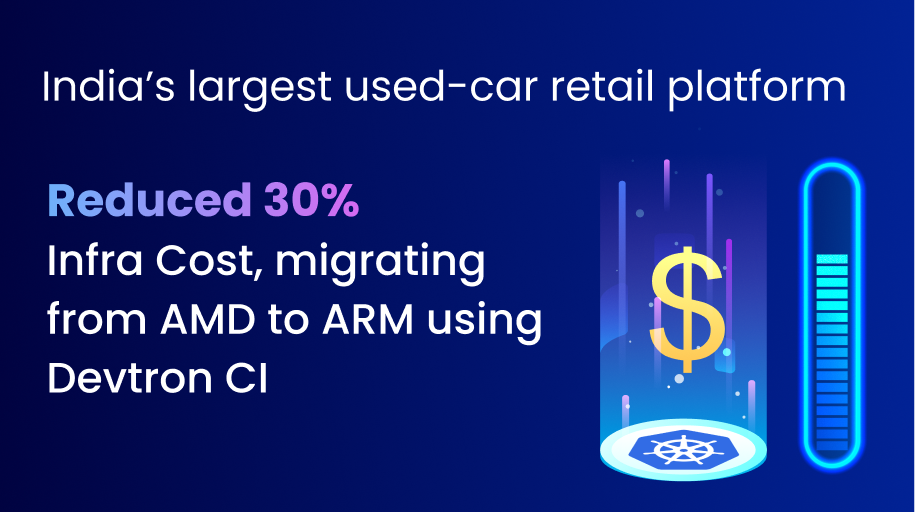Achieved Milestones
- Reduced Infrastructure Costs by 30%
- Enhanced Performance by 25% in Key Workloads
- Improved System Scalability and Efficiency
- Simplified Configuration Management and Reduced Manual Overheads
About the Company
The company is a prominent player in the automotive marketplace, focusing on enhancing how vehicles are bought and sold through innovative technology solutions. The mission of the company is to transform the used car buying experience using advanced data analytics and artificial intelligence.
Background
With increasing operational costs and the need for better performance from its infrastructure. The existing infrastructure was based on AMD processors, which, while reliable, became increasingly expensive as the company's demands grew. They decided to migrate to ARM-based processors, known for their cost efficiency and performance advantages. The migration was managed using Devtron CI, a modern Kubernetes-native CI/CD platform, to ensure a seamless transition.
Challenges with AMD Infrastructure
Before the migration, the company's infrastructure was heavily dependent on AMD processors. While these processors were powerful, they came with challenges:
- High Operational Costs: The AMD infrastructure required significant investment in both hardware and energy consumption. As the company scaled, these costs became a significant burden.
- Performance Bottlenecks: Although AMD processors performed well, certain workloads, particularly those involving heavy parallel processing, started to show signs of inefficiency. This was particularly evident in workloads related to AI and data analytics.
- Complex Migration Process: Transitioning to ARM involved recompiling and optimizing applications, managing dependencies, and fine-tuning performance, which were resource-intensive and complex tasks.
Migration to ARM Architecture
The decision to migrate to ARM was driven by several factors:
- Cost Savings: ARM processors are known for their power efficiency, which translates to lower energy consumption and reduced operational costs. The company estimated a cost reduction of up to 30% in its computing costs post-migration.
- Performance Improvements: ARM's architecture is optimized for parallel processing, which is crucial for workloads involving machine learning and real-time data processing. The company observed a performance improvement of up to 25% in these workloads after the migration.
- Scalability: ARM processors offered better scalability options, allowing them to handle increasing workloads without a linear increase in costs.
Challenges Faced During the Migration
Despite the clear benefits, the migration was not without challenges:
- Compatibility Issues: Many of the applications were optimized for AMD architecture. Recompiling and optimizing these applications for ARM was a complex task that required significant development effort.
- Dependency Management: Some third-party libraries and dependencies did not have native ARM support, necessitating workarounds or alternative solutions.
- Performance Tuning: While ARM offered better performance overall, certain workloads required fine-tuning to achieve the desired performance levels. This involved iterative testing and optimization.
Solution: How Devtron CI Facilitated the Migration
Devtron CI played a critical role in the successful migration from AMD to ARM:
- Automated CI/CD Pipelines: Devtron's automated pipelines allowed for continuous integration and deployment, making it easier to test and deploy applications on the new ARM infrastructure without manual intervention.
- Cross-Architecture Support: Devtron provided tools and frameworks that supported both AMD and ARM architectures, making the transition smoother. It allowed the company to maintain dual support during the migration, reducing downtime and ensuring continuity.
- Monitoring and Rollback Capabilities: Devtron's monitoring features enabled real-time tracking of application performance on ARM infrastructure. In case of any issues, the rollback features allowed them to revert to the AMD setup without significant downtime, ensuring business continuity.
- Collaboration and Feedback Loop: Devtron enabled seamless collaboration between teams, providing a unified platform for developers, operations, and quality assurance teams to work together. The feedback loop created through Devtron's reporting and alerting mechanisms allowed for the quick resolution of issues.
Conclusion
The migration from AMD to ARM using Devtron CI was a strategic move for the company, resulting in significant cost savings and performance improvements. While the process involved overcoming several challenges, the robust capabilities of Devtron CI ensured a smooth transition. The company now enjoys a more cost-effective, scalable, and high-performance infrastructure, positioning the company well for future growth.








